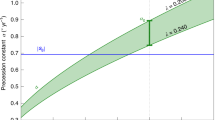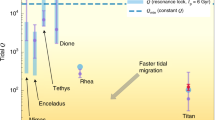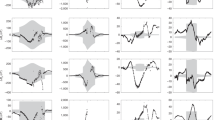Abstract
Prodigious amounts of heat are generated in Jupiter's satellite Io, as evidenced by its spectacular volcanism1 and infrared heat flux2–6 (∼7.6×l013 W (ref. 7)). Such heating had been predicted from tidal flexing of Io due to the eccentricity of its orbit8, which is maintained by its resonant gravitational interaction with the satellites Europa and Ganymede. The energy for tidal heating must come from Io's orbit, but due to the resonance the energy loss is shared among the three satellites' orbits9,10. This effect modifies the rate at which Io's semi-major axis would be expected to decrease, and also tends to drive the system out of resonance. Yoder9 suggested that the resonance is maintained by tides raised on Jupiter by Io, which act to transfer planetary rotational energy and angular momentum into Io's orbit, but the jovian torque may be insufficient for this purpose. Greenberg10 proposed that with smaller jovian torque the system may be evolving away from resonance, and that measurement of Io's orbital acceleration could show whether the evolution is in fact dominated by heating in Io. An acceleration value ṅ1/n1=4.6×10−l0 yr−1±20%, where n1 is Io's mean motion, derived11 from historical records of Io's motion, is in accord with the expected value ṅ1/n1=3.2×10−10±28% based on the measured thermal radiation and the assumption of negligible jovian torque. A much smaller negative acceleration has been determined by Lieske12,13, which would imply significant jovian torque, but not enough to maintain the equilibrium proposed by Yoder, unless the average tidal disruption in Io is much less than is indicated by the thermal flux.
This is a preview of subscription content, access via your institution
Access options
Subscribe to this journal
Receive 51 print issues and online access
$199.00 per year
only $3.90 per issue
Buy this article
- Purchase on Springer Link
- Instant access to full article PDF
Prices may be subject to local taxes which are calculated during checkout
Similar content being viewed by others
References
Morabito, L. A., Synnott, S. P., Kupferman, P. N. & Collins, S. A. Science 204, 972 (1979).
Hanel, R. et al. Science 204, 972–976 (1979).
Sinton, W. M. et al. Science 210, 1015–1017 (1980).
Morrison, D. & Telesco, C. M. Icarus 44, 226–233 (1980).
Matson, D. L. et al. J. geophys. Res. 86, 1664–1672 (1981).
Johnson, T. V. et al. Science 226, 134 (1984).
McEwen, A. S., Matson, D. L., Johnson, T. V. & Soderblom, L. A. J. geophys. Res. 90, 12345–12379 (1985).
Peale, S. J. et al. Science 203, 892–894 (1979).
Yoder, C. F. Nature 279, 767–770 (1979).
Greenberg, R. in Satellites of Jupiter (ed. Morrison, D.) 65–92 (University of Arizona Press, Tucson, 1982).
Goldstein, S. J. & Jacobs, K. C. Astr. J. 92, 199–202 (1986).
Lieske, J. H., Preprint. Jet. Prop. Lab. (1986).
Lieske, J. H. in Relativity in Celestial Mechanics and Astronomy (eds Kovalevsky, J. & Blumberg, V. A.) 117–125 (Reidel, Dordrecht, 1986).
Goldreich, P. Mon. Not. R. astr. Soc. 126, 257–268 (1963).
Yoder, C. F. & Peale, S. J. Icarus 47, 1–35 (1981).
DeSitter, W. Leiden Ann. 16, Pt 2 (1928).
DeSitter, W. Mon. Not. R. astr. Soc. 91, 706–738 (1931).
Peters, C. F. Astr. J. 78, 951–956 (1973).
Ferraz-Mello, S. Cel. Mech. 12, 27–37 (1975).
Goldstein, S. J. Astr. J. 90, 1900–1905 (1985).
Peale, S. J. & Greenberg, R. Proc. lunar planet Sci. Conf. 11, 871–873 (1980).
Greenberg, R. Bull. Am. astr. Soc. 17, 921–922 (1985).
Ojakangas, G. W. & Stevenson, D. J. Icarus 66, 341–358 (1986).
Author information
Authors and Affiliations
Rights and permissions
About this article
Cite this article
Greenberg, R., Goldstein, S. & Jacobs, K. Orbital acceleration and the energy budget in the galilean satellite system. Nature 323, 789–791 (1986). https://doi.org/10.1038/323789a0
Received:
Accepted:
Issue Date:
DOI: https://doi.org/10.1038/323789a0
Comments
By submitting a comment you agree to abide by our Terms and Community Guidelines. If you find something abusive or that does not comply with our terms or guidelines please flag it as inappropriate.



